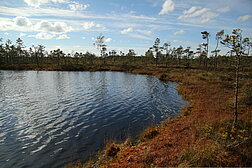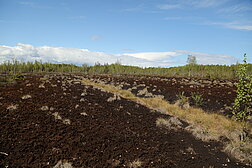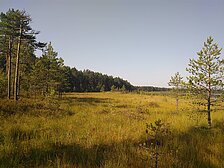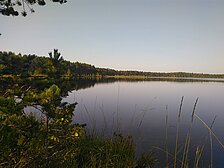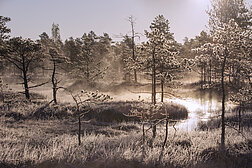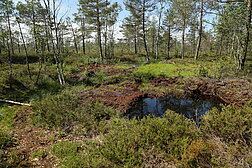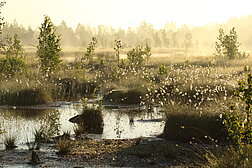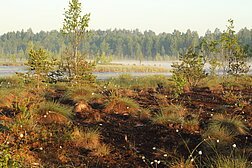Established in 1999, in Marupe Municipality, Cenas Mire Nature Reserve is comprised of 2133 ha of land. The nature reserve is owned by Rigas Municipality and managed by “ Rīgas Meži”. The mire is located in a depression between old and new shores of the Baltic Sea, with a prominent hummock-hollow micro-relief with raised bog pools. It is also located directly on the watershed between the Lielupe and Daugava rivers, in a coastal geobotanical region. 95% of the territory is made up of five European Union habitats of special significance: active raised bogs, degraded raised bogs, transitional mires and quacking bogs, bog forests and dystrophic lakes. The need to protect this area is emphasized by its significance for migrating bird species, unique flora and intact raised bog ecosystem.
Drainage of the bog in the beginning of the 20th century for peat extraction caused the water table to lower drastically. Afforestation of the bog increased, decreasing the native moisture loving plants. Changes in the hydrology led to a decrease in Shagnum mosses and suitable open landscapes for migrating birds, and an increase in heather (Calluna vulgaris) and pine (Pinus sylvestris). Since the implementation of the nature protection plan “LIFE Mires” (LIFE04 NAT/LV/000196) in 2007, 73 large and 107 small dams were built in drainage ditches, increasing the water table in the bog. You can read more about the nature protection plan here.
Lielais Pelečāres Mire is made up of 5 684.34 ha and is located in four municipalities; Sīļukalna, Rudzātu, Atašienes un Varakļānu parishes. The majority of the peatland (92.98%) is owned by the state and managed by JSC “Latvijas Valsts Meži,” while the rest is owned by municipalities and individuals. The bog is located in a depression formed by a glacier in the Daugava river basin and Lubāna and Jeriska River hydrological regions. It resulted from the overgrowing of glacial lakes and depressions. The territory mainly comprises raised bog vegetation, but has fragments of fens and transitional mires as well. The dome of the raised bog has hummock - hollow and ridge - bog pool microrelief. Together with Teičas Mire, the peatland is part of the List of Wetlands of International Importance (2015) and Ramsar Convention’s list of Wetlands of International Importance (1971). Moreover, 88.14% of the territory is made up of ten European Union habitats of significance. The area hosts 55 species of great significance, including the EU Directive large copper butterfly (Lycaena dispar).
Construction of drainage ditches in the southern and western parts of the peatland has caused the water table to lower. Bog vegetation has reduced and afforestation increased. The area was given a special status in 1977 originally as a cranberry protection reserve, but in 1999 was given a proper nature reserve status. In 2015 began the elaboration of the Nature Protection Plan for Lielais Pelečāres Mire. More about the nature protection plan can be found here.
Having been formed 10 300 years ago, Sudas-Zviedru Mire is one of Latvia’s oldest peatlands. The mire is located in Gaujas National Park and consists of all three Latvian bog types: fens, transition mires and raised bogs. All parts have developed differently. For example, resulting from the overgrowing of lakes and land paludification. Fens and transitional mires are soaked with mineral-rich springs, while raised bogs are fed by rainwater. The Sudas river and Zušu-Staiņu springs flow out from the southern end of the mire. In the peatland three domes and three mineral islands (Purgaiļu, Ģipsalavas and Čaules) can be found. The peatland is made even more special by having both eastern and western bog characteristics.
Draining of the northern are of the peatland occurred in the 1930s for peat excavation. Although a large part of the drainage ditches are overgrown, they still actively induce drainage. Due to the lowering of the water table, Sphagnum, cotton-grass (Eriophorum spp.) and other common raised bog species have been replaced in places by species such as heather (Caluna spp.), birch (Betula spp.) and pine (Pinus sylvestris). The need for protecting the bog is made even greater by it being home to rare bird species such as the black stork (Ciconia nigra) and the black grouse (Tetrao tetrix). In 2017, as part of the “LIFE Wetlands” (LIFE13 NAT/LV/000578) project, 67 dams were built in drainage ditches. The dams have successfully stopped further drainage from the peatland and stabilized areas hydrology. In addition to building the dams, at the end of 2017 and spring of 2018 a radical Sphagnum reintroduction experiment was implemented in degraded areas of the peatland. Already in 2018, the Shagnum reintroduction experiment was visibly successful, with the Shagnum growing abundantly with other bog species also beginning to grow in these areas. You can read more about the Sudas-Zviedru nature protection plan here.
Melnais Lake Mire used to be part of what once was the 10 000 ha Cenas Mire. The peatland was formed 5000-6000 years ago and nowadays takes up only 317 ha. Formation took place mainly within the last thousand years, when the bog underwent all stages of bog formation – from fens to raised bogs. The hydrology is formed by surrounding waters flowing into the area. It is known that every year 1 mm of peat is formed, although that number is insignificant when looking att the fast rate at which peat is extracted. From the intensely cultivated land, three areas of significance of European Union standards can be found: intact raised bog, transition mire and quacking bogs, and degraded raised bogs that can undergo natural regeneration. The bog also hosts two EU forest biotopes of significance – bog woodlands and western taiga, and one EU lake biotope of significance – dystrophic lakes. The bog is home to common bog species, such as Sphagnum moss, sundews (Drosera spp.), hare’s-tail cotton-grass (Eriophorum vaginatum) and sedge (Carex spp.). Although within the flora there are no rare species, the peatland is bountiful in rare bird species. One of the 17 birds from the EU’s Bird Directive, Appendix I, includes the eagle owl (Bubo bubo).
Most of the peatland has been drained for peat extraction and farmland formation, starting in the 1920s and ‘30s, and continuing today. Drainage ditches occupy a whopping 84% of the areas perimeter, having drastically changed the bog’s hydrology. As a result of the lowering of the water table, much of the typical flora and open bog landscape has disappeared. Completely renewing old peat extraction sites is not possible, but decreasing the drainage rate is. Therefore, project “LIFE Raised Bogs” (LIFE08 NAT/LV/000449) was implemented to restore the area’s hydrology. During the time of the project, dams were built in old drainage ditches and the hydrology indeed was stabilized. Bog vegetation even started to return to degraded areas. You can read more about the Melnais Lake Mire protection plan here.

 Academic Centre
Academic Centre